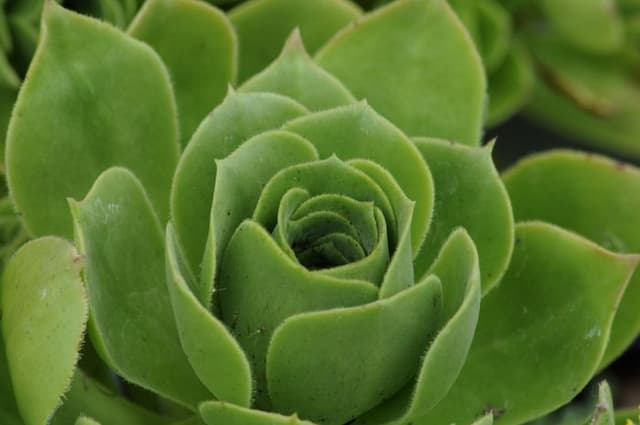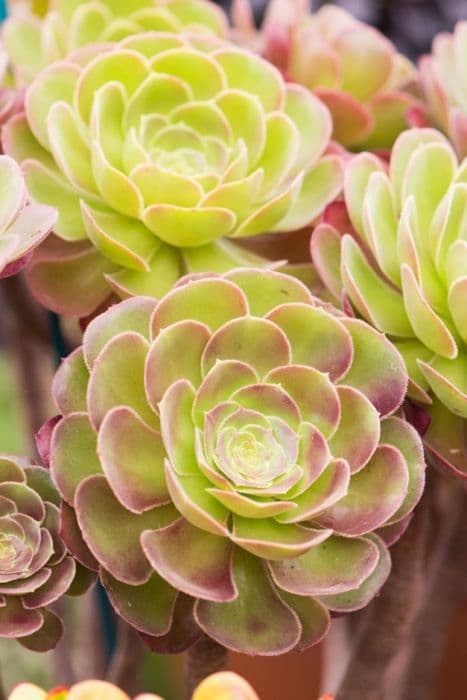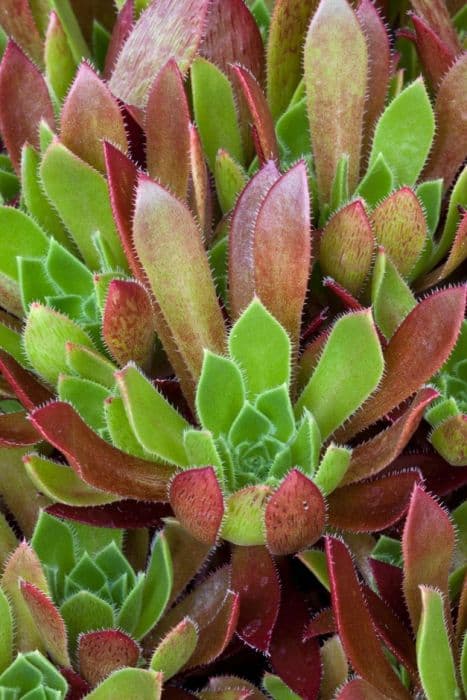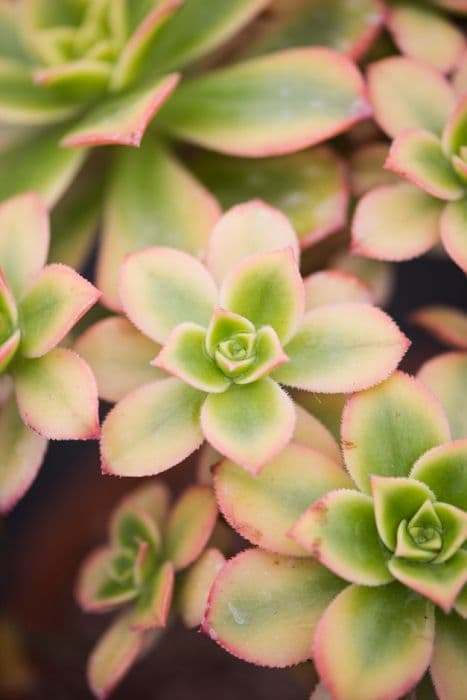Navelwort Umbilicus oppositifolius

ABOUT
Umbilicus oppositifolius, commonly known as the wall pennywort, is notable for its distinctive circular, fleshy leaves that resemble coins. The leaves are often described as rounded and peltate, meaning that the leaf's stem attaches to the center of its underside rather than the edge. This gives the wall pennywort a very unique appearance as if the leaves are little green plates attached by a single point to the stems. The plant bears small bell-shaped flowers that are organized in long, slender clusters, reaching outward or dangling from the central stalk. These flowers typically exhibit a pale hue, nothing overly vibrant, yet they are attractive to pollinators like bees. Overall, the wall pennywort presents an aesthetic that is both unusual and striking, with its coin-like leaves providing a pleasing texture and form.
About this plant
 Names
NamesSynonyms
Opposite-leaved Pennywort, Maltese Pennywort.
Common names
Cotyledon umbilicus-veneris var. oppositifolia, Cotyledon oppositifolia, Umbilicus horizontalis, Umbilicus oppositifolius var. kotschyanus.
 Toxicity
ToxicityTo humans
Navelwort, also known as Umbilicus oppositifolius, is not known to be toxic to humans. There are no widespread reports or studies indicating that navelwort causes poisoning when touched or ingested. Therefore, consuming or coming into contact with navelwort is not commonly associated with adverse health effects or symptoms of poisoning in humans.
To pets
Navelwort is not typically listed as a toxic plant to pets. Umbilicus oppositifolius does not appear in lists of plants known to cause poisoning in pets such as dogs, cats, or other domestic animals. As such, it is unlikely that ingestion of navelwort would lead to significant symptoms of poisoning or severe health consequences in pets. However, as with any non-food plant, ingestion of large amounts could potentially cause mild stomach upset in some animals due to the ingestion of non-digestible matter.
 Characteristics
CharacteristicsLife cycle
Perennials
Foliage type
Deciduous
Color of leaves
Green
Flower color
Green
Height
1 foot 6 inches (45.72 cm)
Spread
1 foot (30.48 cm)
Plant type
Herb
Hardiness zones
9
Native area
Mediterranean
Benefits
 General Benefits
General Benefits- Decorative plant - Umbilicus oppositifolius, commonly known as the wall pennywort, adds a unique aesthetic to gardens with its rosettes of rounded leaves and stalks of bell-shaped flowers.
- Drought-resistant - Wall pennywort is capable of withstanding periods of low water availability, making it suitable for xeriscaping and low-maintenance gardens.
- Erosion control - Its root system helps stabilize soil in areas prone to erosion, making it a practical choice for hillside planting and landscape restoration projects.
- Shade tolerant - It can thrive in shady conditions where other plants might struggle, offering greenery and cover in dimly lit areas of a garden.
- Ground cover - With its tendency to spread, wall pennywort serves as an effective ground cover, filling spaces between other plants and helping to suppress weeds.
- Bee-friendly - The flowers of the wall pennywort attract bees and other pollinators, supporting biodiversity and the health of the surrounding ecosystem.
 Medical Properties
Medical Properties- This plant is not used for medical purposes.
 Air-purifying Qualities
Air-purifying QualitiesThis plant is not specifically known for air purifying qualities.
 Other Uses
Other Uses- Umbilicus oppositifolius, commonly known as "Navelwort", has been used as a survival food in ancient times, where the succulent leaves provided a juicy, although not particularly flavorful, source of hydration and emergency nutrition.
- In some cultural practices, the leaves of Navelwort have been used as a natural plaster for small superficial wounds due to their adhesive and slightly antiseptic properties.
- Gardeners sometimes use Navelwort to introduce a touch of greenery into shady rock gardens or to occupy space between stones, as they are able to grow in minimal soil.
- In the past, the mucilaginous texture of Navelwort made it a candidate for a natural thickening agent in soups and broths, though this use is not commonly found in modern cuisine.
- Due to its appearance, Navelwort can be utilized in miniature and fairy gardens to create a sense of a lush landscape on a tiny scale.
- Enthusiasts of natural dyeing sometimes experiment with Navelwort for dyeing fabrics, although it doesn't yield a strong color and is not well-documented.
- Crafters use the strikingly patterned leaves of Navelwort to create botanical prints, pressing them onto paper or fabric to leave an impression of their shape and texture.
- Visual artists occasionally use the sap from the Navelwort stems as a component in natural ink or paint mixtures.
- Navelwort can be planted in outdoor containers with mixed species to add variety of textures and to serve as a "spiller" element, with its leaves cascading over the edge of pots.
- In some traditions, it was believed that carrying a leaf of Navelwort could ward off bad luck, and so it was often kept in pockets or woven into garlands for protection.
Interesting Facts
 Feng Shui
Feng ShuiThe plant Umbilicus oppositifolius, commonly known as Pennywort, is not used in Feng Shui practice.
 Zodiac Sign Compitability
Zodiac Sign CompitabilityThe plant Pennywort is not used in astrology practice.
 Plant Symbolism
Plant Symbolism- Healing: Umbilicus oppositifolius, commonly known as Navelwort, often symbolizes healing due to its historical use in herbal medicine for treating wounds and inflammation.
- Protection: Navelwort grows in cracks and crevices, symbolizing protection and the ability to survive in challenging environments.
- Resilience: The plant's ability to retain water and thrive in harsh conditions makes it a symbol of resilience and adaptability.
 Water
WaterNavelwort prefers consistent moisture and should be watered when the top inch of soil feels dry to the touch. Watering it thoroughly once a week with half a gallon of water is generally adequate, but this may vary depending on climate conditions. During hot, dry periods, it may require more frequent watering. Be careful not to overwater, as this could lead to root rot. It's important to water the plant at the base and avoid wetting the foliage to prevent disease.
 Light
LightNavelwort thrives in partial shade, ideally receiving filtered sunlight for most of the day. It should be kept away from intense, direct sun exposure which can scorch the leaves. A spot that receives morning light and afternoon shade or dappled sunlight throughout the day is optimal.
 Temperature
TemperatureNavelwort does well in a wide range of temperatures, typically between 50 and 80 degrees Fahrenheit. It should not be exposed to temperatures below 30 degrees Fahrenheit, as it is not tolerant of hard frost. Ideally, maintain an environment where temperature fluctuations are minimal to keep the plant healthy.
 Pruning
PruningPruning Navelwort is mainly done to remove dead or damaged leaves and to maintain a neat appearance. Pruning can be done as needed throughout the year, with the best time being in late winter or early spring before new growth begins. Occasionally cut back leggy stems to encourage bushier growth.
 Cleaning
CleaningAs needed
 Soil
SoilThe Pennywort (common name for Umbilicus oppositifolius) requires a well-draining soil mix rich in organic matter. It thrives in slightly acidic to neutral pH levels, generally between 6.0 and 7.5. A mix combining loamy garden soil, peat, and perlite or sand will ensure proper drainage and aeration.
 Repotting
RepottingPennywort plants should be repotted every two to three years or when they outgrow their current pot. This helps to refresh the soil nutrients and provides room for further root growth.
 Humidity & Misting
Humidity & MistingPennywort prefers moderate to high humidity levels, ideally between 50% and 70%. Without adequate humidity, the leaves may dry out or develop brown tips.
 Suitable locations
Suitable locationsIndoor
Place Pennywort in bright, indirect light and maintain humidity.
Outdoor
Grow Pennywort in partial shade and protect from strong winds.
Hardiness zone
7-10 USDA
 Life cycle
Life cycleNavelwort (Umbilicus oppositifolius) begins its life cycle as a seed, which, when conditions are favorable, germinates and sprouts into a small seedling. The seedling develops into a rosette of fleshy, round leaves, characteristic of the plant, from which it derives its common name due to the navel-like depression in the center. As it matures, Navelwort produces a stalk with small bell-shaped flowers, usually in the spring or early summer, which are pollinated by insects, leading to the production of seeds. After pollination, the flowers develop into fruit capsules containing the seeds, which, once mature, are dispersed by wind, gravity, or possibly by animals. The plant often dies back in winter, surviving the colder months as a perennial through its fleshy leaves and underground tubers before re-emerging in spring. This cycle of growth, reproduction, seed dispersal, and dormancy continues, allowing Navelwort to persist and spread within its environment.
 Propogation
PropogationPropogation time
Spring to early summer
Propogation: For the Umbilicus oppositifolius, commonly known as Navelwort, the most popular method of propagation is through division in the spring or early summer. To propagate Navelwort by division, gently lift the plant from the ground, ensuring that you preserve as much of the root system as possible. Carefully separate the clumps into smaller sections, each with its own roots and shoots. These sections can then be immediately replanted in moist, well-drained soil at the same depth they were originally growing, and should be spaced approximately 6 to 8 inches (15 to 20 centimeters) apart to allow for growth. Regular watering ensures the new divisions establish quickly, with the warm spring or early summer temperatures promoting root and shoot development.









